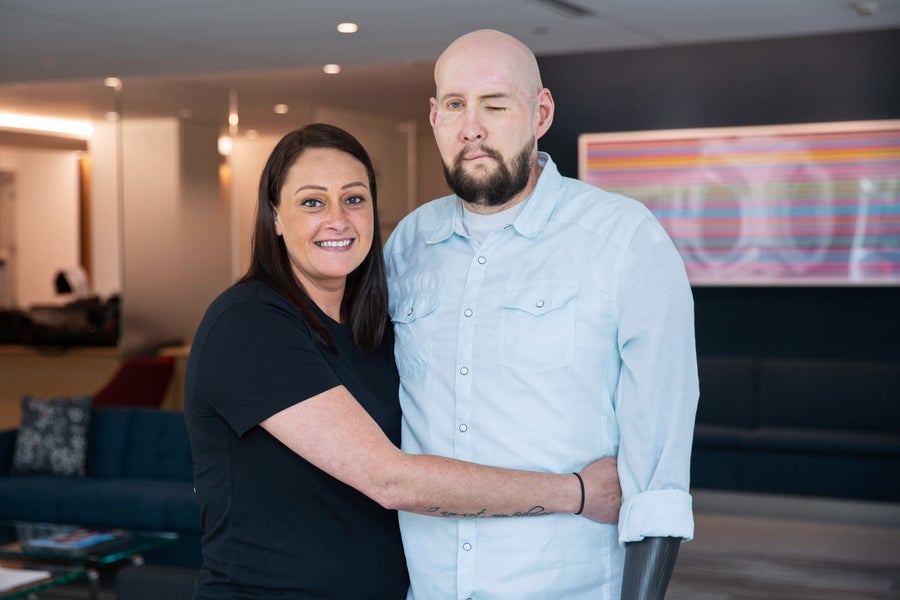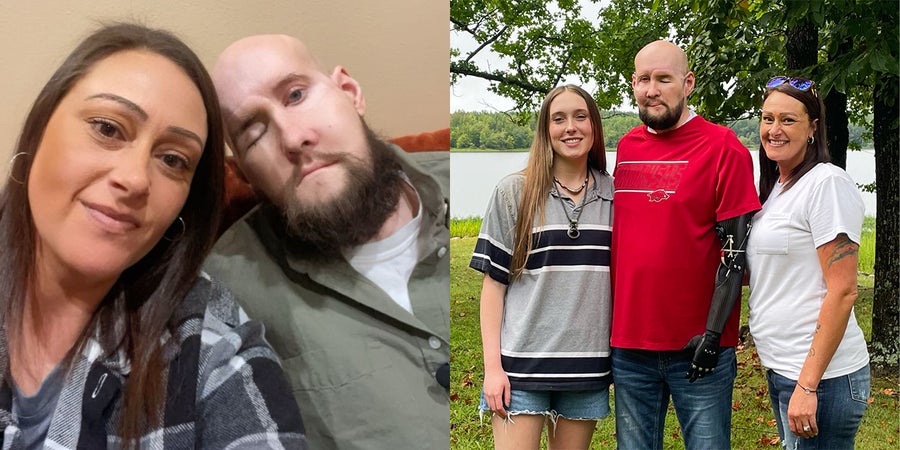In June of 2021 Aaron James experienced a terrible accident while working as an electrical lineman. The 46-year-old military veteran and Arkansas resident lost much of the left side of his face—including his left eye—to severely disfiguring electrical burns that also destroyed his left arm.
Two years later James received the first-ever partial face and whole-eye transplant, performed by surgeons at NYU Langone Health in New York City. And now, more than a year after that, James has made a strong recovery with no evidence of tissue rejection, his medical team reported in a paper published on Monday in JAMA. He still lacks any vision in the transplanted eye, but the eye itself has maintained its shape and blood flow—and there is evidence of electrical activity in the retina in response to light.
Other researchers say the findings represent a step toward successful whole-eye transplants while illustrating the challenge of regenerating the optic nerve after a major injury.
On supporting science journalism
If you’re enjoying this article, consider supporting our award-winning journalism by subscribing. By purchasing a subscription you are helping to ensure the future of impactful stories about the discoveries and ideas shaping our world today.
“It’s a delightful surprise that the surgery has worked so well, that the patient is so happy, that the aesthetic or cosmetic outcome has worked so well. The eyeball itself has stayed alive and is able to stay in that space and can continue to contribute to the overall success of hemifacial transplant,” says Jeffrey Goldberg, a professor and chair of ophthalmology at the Byers Eye Institute at Stanford University, who was not involved in the study but wrote a commentary on it that was published in the same issue of JAMA.
The lack of restored vision was not unexpected, Goldberg says, because preclinical studies in animals have shown the difficulty of regrowing an optic nerve. He notes that the surgical team’s technique of injecting the tissue surrounding the optic nerve with stem cells from James’s bone marrow has not been validated in animals and could pose a safety risk if the cells grew into a tumor. Fortunately, there is no evidence of this happening to date. Another risk was that if the donor eye’s optic nerve had regrown, it could have compromised the vision in James’s other eye because of the way input from the two eyes can interact in the brain. There is no sign of this complication either, however. This exciting first case helps lay the groundwork to push whole-eye transplant into a vision-restoring reality, Goldberg says.
Whole-eye transplants have long been a dream among doctors and scientists seeking to treat people with serious eye injuries or blindness. The first corneal transplant took place in 1905. But efforts to transplant an entire eye have been thwarted by the devilish difficulty of regrowing the optic nerve, which carries signals from the eye’s light-sensitive retina to the brain’s visual centers, where they are perceived as sight. While there had previously been limited success in efforts to regenerate the optic nerve in some animals, no one had succeeded in transplanting a whole eye into a human until now.
Aaron James (left) with Eduardo Rodriguez, director of the face transplant program and chair of the department of plastic surgery at NYU Langone Health.
Haley Ricciardi/NYU Langone Health
“Aaron has had amazing functional improvement, and the aesthetic result is remarkable,” says Eduardo Rodriguez, one of the many physicians involved in James’s care. “My ultimate goal was to preserve [the eye] alive,” says Rodriguez, who is director of the face transplant program and chair of the department of plastic surgery at NYU Langone Health. “The fact we achieved that is remarkable. What would happen afterward, no one could say, because it had never been done.”
Even though James’s transplanted eye lacks vision, the fact that it has maintained its shape and blood supply for more than a year is remarkable, says Vaidehi Dedania, an associate professor in the department of ophthalmology at the NYU Grossman School of Medicine, who has been monitoring the eye’s health. The retinal cells’ response to light was also surprising, she says, adding that “an eye has not been transplanted from one human to another before and continued to survive and sustain itself within that body for so long.”
Aaron James and his wife Meagan James were in New York City in August to meet with his medical team as part of his postoperative monitoring. Scientific American sat down with them to discuss Aaron James’s recovery and what this surgery has meant for his life.
[An edited transcript of the interview follows.]
It’s been a little under a year and half since your transplant surgery. How are you doing?
AARON JAMES: Everything’s going good. It’s been, as you said, a little over a year, and the face is still kind of moving. There’s still work to be done. I’m still going to speech therapy. And just because we had the surgery, that doesn’t mean it’s finished. We’ve still got a lot of maintenance to do. But, I mean, I feel good. All my blood work and stuff has come back good. And so, yeah, we’re just kind of holding where we’re at right now, you know?
Your face looks like it’s healed really well.
AARON JAMES: It’s amazing how well the body can regenerate. It’s great. There are a lot of people that don’t even know that I’ve had a face transplant.
I know you don’t have any vision in the transplanted eye, but do you have any pain or discomfort?
AARON JAMES: No. I mean, it feels just like my own. There’s no pain. [The doctors] were kind of concerned in the beginning that there might be a lot of pain, but it’s really just exceeded expectations—I mean, just the fact that it’s still alive after almost a year and a half. Right after the surgery, they were like, “Okay, it’s survived the surgery. Now let’s do 90 days.” And we made it past 90 days. And it just keeps going and going. So we’re kind of in uncharted waters right now. We’re just kind of seeing what happens next.
How does it feel to be the first person to have had this surgery?
AARON JAMES: It feels good. To be a part of this, it’s kind of overwhelming, I guess, because we’re just a simple family from Arkansas. If I can be a part of something that gets it started, that makes me feel good, it makes me feel like I’ve helped out possibly millions of people in the future.
Ever since my accident, it’s made me think about stuff that I normally wouldn’t give a second thought to. Now I think of people with visual problems. There are so many people who have visual impairments, and once I thought about it, I thought, “I can’t believe something hadn’t been done before because there are so many people with eye issues. So it’s about time.”
What has your life been like in the past year? Have you been able to get back to doing things you did before the accident?
AARON JAMES: In the beginning, once we got home, I’d have to kind of watch what I was doing because of my white blood cell count. It was kind of fluctuating. But, knock on wood, I think we finally got that hopefully figured out. There’s still stuff I have to kind of watch out for, you know, being out in the sun too long [because the immunosuppressive drugs increase the risk of skin cancer]. But that’s really not that big of a deal.
Have you had any immune rejection of the face or eye or other complications?
AARON JAMES: No.
Did your vision in your right, nontransplanted eye change after the accident?
AARON JAMES: Yeah, it formed a cataractfirst, and they had to remove that. I wear a contact and reading glasses if I need to see something up close.

Haley Ricciardi/NYU Langone Health
What are some of the emotional challenges you’ve both experienced?
AARON JAMES: We live about two and a half hours from the rest of our family. My mom is in a nursing home because she had a stroke. So that’s kind of hard because they’ve always got COVID cases and stuff in this nursing home, so I can’t really go up there like I want to because I can’t really be around that stuff.
MEAGAN JAMES: Just the amount of things that it entails, from the beginning of the accident. Aaron mentioned his mom had a stroke. And a few months after that, I actually lost my mom. And then, a few months ago, I lost a sister to breast cancer she had battled for five years. So it’s a lot of extra mental toll on top of the amount of mental toll that it is. We’ve definitely become closer through all of this.
AARON JAMES: Yeah, definitely. And now we’ve got our daughter fixing to start college. So now we can kind of focus on real life—regular stuff. It’s finally getting back on track.
Have you found any helpful ways to cope with the recovery?
AARON JAMES: One way we deal with it is having a sense of humor—joke about it, you know?
MEAGAN JAMES: If you listened to our daily conversations, you probably wouldn’t believe any of this. We’re just mean to each other, but it’s just our way of coping, I guess. We have fun with stuff; we joke and laugh.

Aaron James with Meagan (left). Aaron James and family (right).
Meagan, is there anything you’d like to say about your experience taking care of Aaron?
MEAGAN JAMES: I always said I was going to be famous one day. But I never expected it would be anything like this that I would be a part of. And it’s pretty amazing to know that I had a small role. They just sent me home with the first transplanted eye and said, like, “Take care of it.” And I’m like, “Who am I to take care of this?”
Aaron, how has this face and eye transplant changed you?
AARON JAMES: It’s definitely something that I still think about every day. I’ll think about everything that’s happened in the past. And now, to be honest, when I look at an older picture of me, it kind of looks weird to me. I recognize it; I know who it is; I know it’s me. But I don’t know—it’s hard to explain that.

